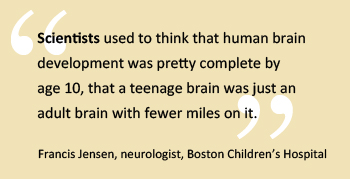

How Youth Learn: A Portfolio to Inform and Inspire Educators, Students, Parents & More
| The Teenage Brain: Research Highlights | SHARE | |
| SEE ALSO: Conditions of Learning | Mind, Brain & Education | Adolescent Development | Mindsets | Motivation & Mastery | Social & Emotional Learning |
While 95 percent of the human brain has developed by the age of six, scientists report that the greatest spurts of growth after infancy occur just around adolescence. What are these changes? How do teenage and adult brains differ?
|
|
|
It will come as no surprise that the adolescent brain is often described as “still immature” or “maturing.” These are kind labels for not-so-kind behaviors: mood swings, surliness, impulsivity, poor decisions, insensitivity (or too much sensitivity), and more. Parents and teachers wish that lectures, rewards, and punishments would turn these difficult behaviors around. Neuroscience research explains why they persist.
- Most of the research on the adolescent brain focuses on the prefrontal cortex. The largest part of the brain, the cortex, is divided into lobes that mature from back to front. The last section to connect is the frontal lobe, responsible for cognitive processes such as reasoning, planning, judgment, and self-regulation—often called “executive” functions. This mental union is completed somewhere between ages 25 and 30—much later than once thought (e.g., Lebel, 2011).
- Imaging studies show that while adults use the frontal lobe for most of their processing, teenagers draw upon the back of the brain (Giedd, 2008). When they do use the frontal lobe, it seems they carry to excess, calling upon much more of the brain to get the job done than adults would (Powell, 2006). And because adults have already pruned those communicating synapses, they can make decisions more quickly.
- Adult brains are also better wired to notice errors in decision-making. In one experiment, when adults performed tasks that required the response of rapidly pushing buttons, their brains sent out a signal when they made a mistake. Before 80 milliseconds had passed, adult brains noticed the blunder, while teenage brains did not (Luna et. al, 2013).
- When responding to external emotional stimuli, not only did adolescents draw more on their anterior lobe (their gut), but often they also misidentified the emotion. When, for example, adult and teen volunteers were shown a clearly frightened face and asked what the person was feeling, one hundred percent of the adults said fear. Only half of the teens did; the rest labeled the emotion as confusion, sadness, or shock (Yurgulen-Todd & Killgore, 2006).
- The adolescent brain is also more vulnerable to stress. Our bodies regulate stress through a system called the HPA (hypothalamic-pituitary-adrenalin) axis. The stress hormones, notably cortisol and noradrenaline, that flood our brain and body when faced with an acute physical emergency were once key to our survival, and fired only occasionally. Chronic stress—from perceived as much as real threats—keeps the HPA switch mostly “on,” and the long-lasting effects can be toxic to our physical, psychological, and emotional wellbeing. It is not the stress itself that is harmful but the body’s reaction to the stress. The process of managing stress, called allostasis, is what wears the body down (McEwen, 2009).
In a 2010 survey by the American Psychological Association, 43 percent of 13- to -14 year-olds said they felt stressed every single day. By ages 15 to 17, the number rose to 59 percent. The negative impact of stress hormones on the brain could not come at a worse time. Stress overloads the prefrontal cortex, making it harder to regulate emotions and thoughts. At the same time that teenagers—and their prefrontal cortex—are struggling to gain the self-control and regulation they need to say on track, stress sends them in the opposite direction (Romero and McEwen, 2006).
The most important point to remember, though, is that the adolescent brain is maturing. As the prefrontal cortex matures, teenagers can reason better, develop more control over impulses, and make judgments better. Adolescence is also a period of consolidation, as the brain prunes away synapses and wraps white matter (myelin) around other connections to stabilize and strengthen them.
There is a “back story” as well. The neuroscientist Jay Giedd describes it this way:
“The cerebellum, in the back of the brain, is the part of the brain that changes most during the teen years and does not finish growing well into the early 20s. The cerebellum used to be thought to be involved in the coordination of our muscles. So if your cerebellum is working well, you were graceful, a good dancer, a good athlete.
“But we now know it is also involved in coordination of our cognitive processes, our thinking processes. Just like one can be physically clumsy, one can be mentally clumsy. And this ability to smooth out all the different intellectual processes to navigate the complicated social life of the teen and to get through these things smoothly and gracefully instead of lurching seems to be a function of the cerebellum.” (Giedd, PBS Frontline, 2002)




